
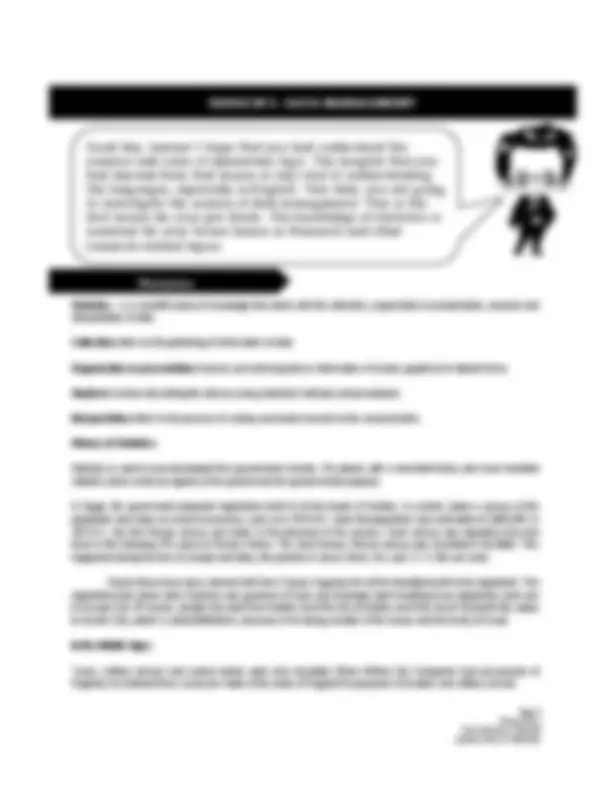
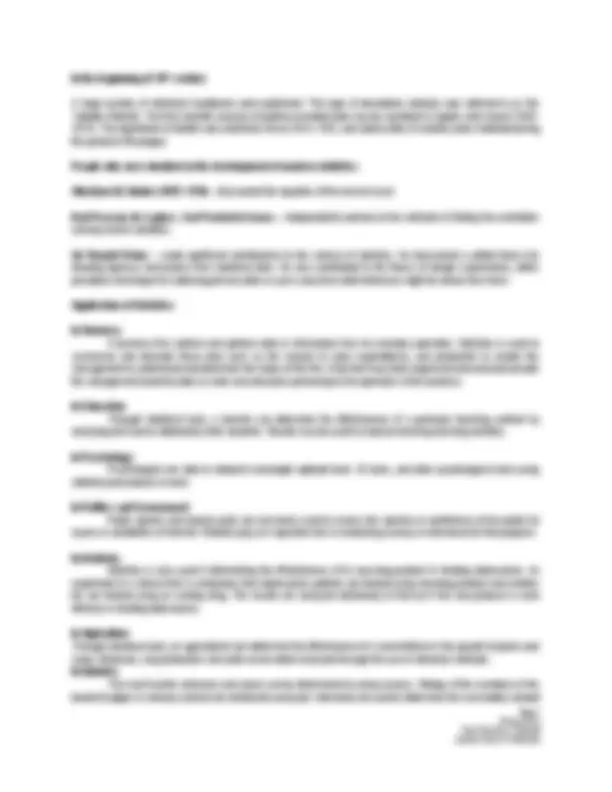
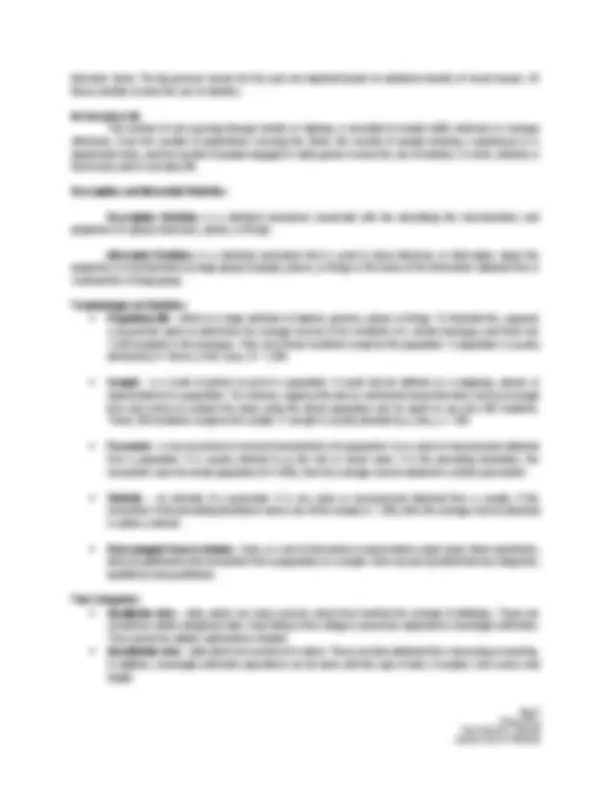
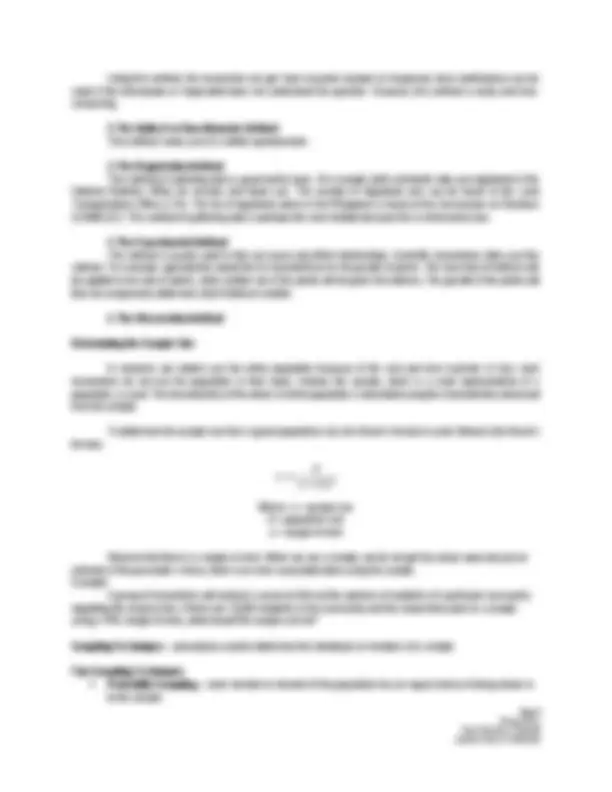
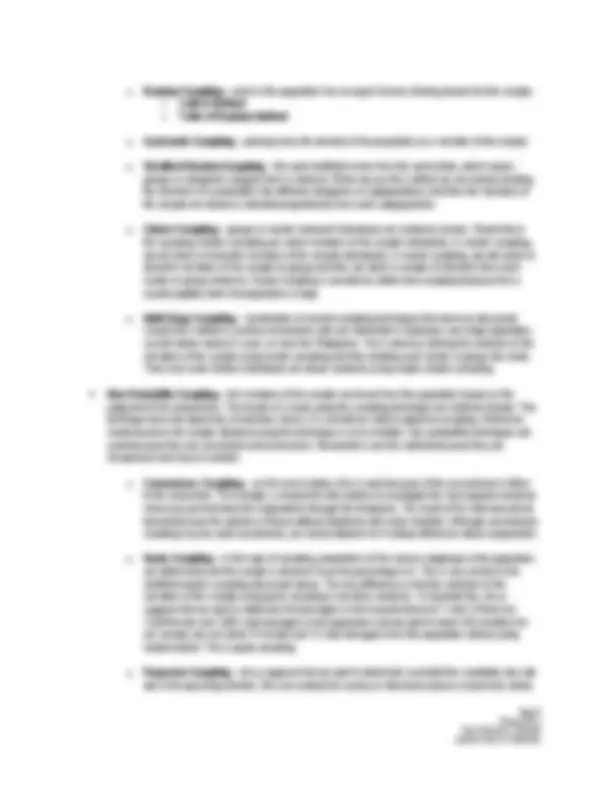
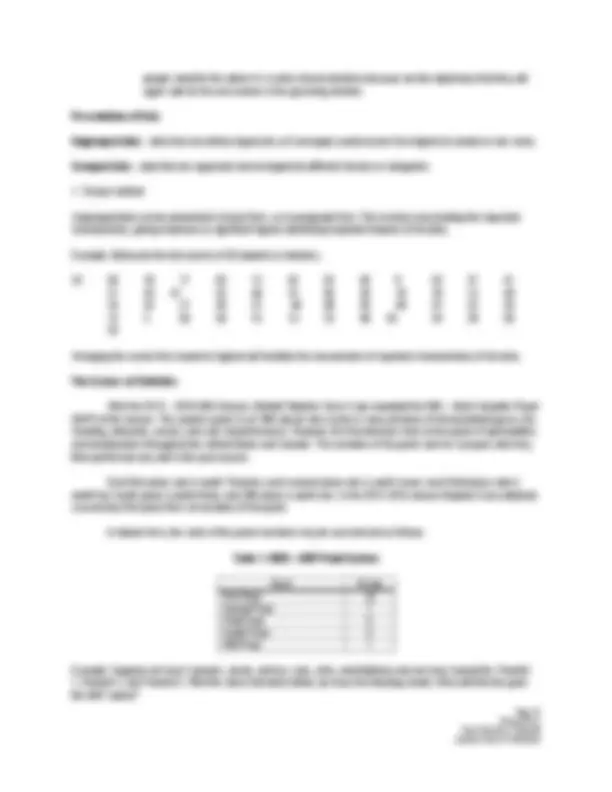
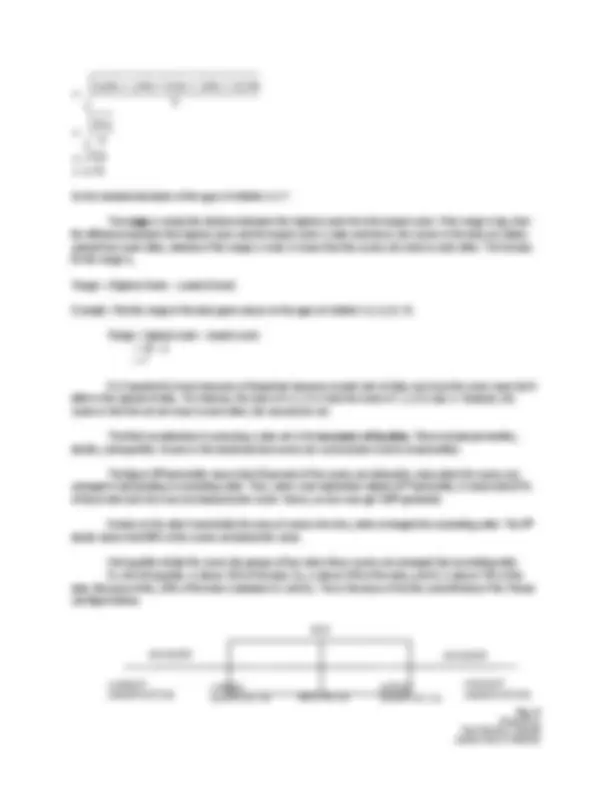
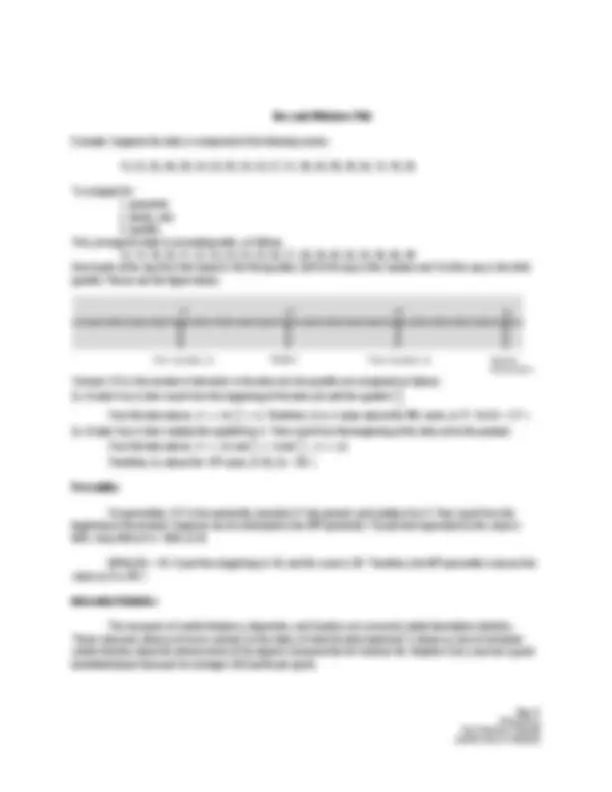
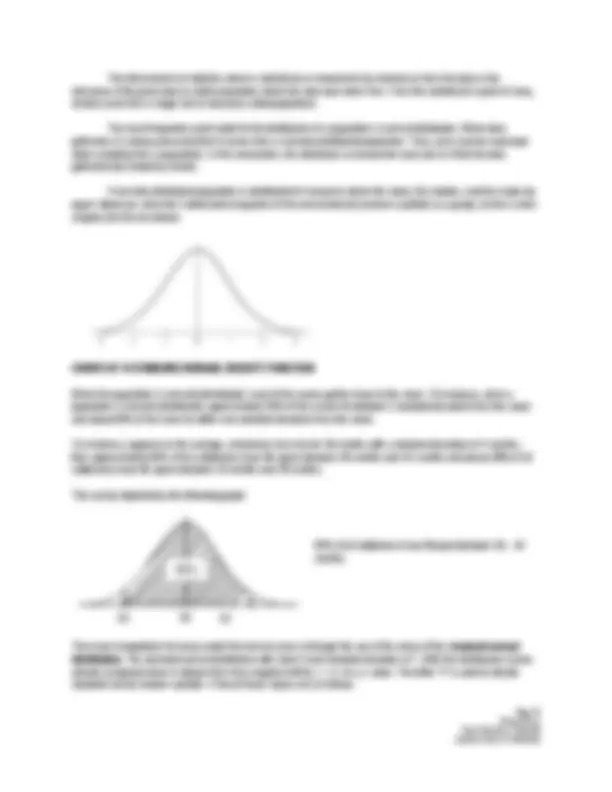


Study with the several resources on Docsity

Earn points by helping other students or get them with a premium plan


Prepare for your exams
Study with the several resources on Docsity

Earn points to download
Earn points by helping other students or get them with a premium plan
Community
Ask the community for help and clear up your study doubts
Discover the best universities in your country according to Docsity users
Free resources
Download our free guides on studying techniques, anxiety management strategies, and thesis advice from Docsity tutors
A study guide for a university course on Mathematics in the Modern World, focusing on the topic of data management and statistics. It covers the concepts of data, qualitative and quantitative data, variables, interval scales, collecting data, primary and secondary data, sampling techniques, and presentation of data. It also includes examples and formulas for measures of central tendency and dispersion.
Typology: Lecture notes
1 / 17

This page cannot be seen from the preview
Don't miss anything!










LUNA ST., LA PAZ, ILOILO CITY P.O. Box 258 ILOILO CITY PHILIPPINES 5000 PHILIPPINES 5000 TELEPHONE Nos.: 3200259 3201475 3200902 3209767 3209853 3209456 FAX No. +6333 3201484 Globe-Islacom No. 5087151 Website: www.wit.edu.ph E-mail: wit@wit.edu.ph
Page 1 Prepared by: Prof. Ninfa Sua – Sotomil
WIT.B.23 Issue: 2 Revision: 0 Approved: President Date: November 24, 2014
Page 2 Prepared by: Prof. Ninfa Sua – Sotomil
Course Number : Math 1
Course Title : Mathematics in the Modern World
Course Description : This course deals with the nature of mathematics, appreciation of its practical and intellectual and aesthetic dimensions, and application of mathematical tools in daily life. The course begins with an introduction to the nature of mathematics as an exploration of pattern (in nature and the environment) and as an application of inductive and deductive reasoning. By exploring these topics, students are encouraged to go beyond the typical understanding of mathematics as merely a set of formulas but as a source of aesthetics in patterns of nature, for example, and a rich language in itself (and of science) governed by logic and reasoning. The course then proceeds to survey ways in which mathematics provide a tool for understanding and dealing with various aspects of present – day living, such as managing personal finances, making social choices, appreciating geometric designs, understanding codes used in data transmission and security, and dividing limited resources fairly. These aspects will provide opportunities for actually doing mathematics in a broad range of exercises.
Pre-requisite: None
Credit Units: 3 Units
Course Outline
Section II. The Mathematics as a Tool
References:
CHED Memorandum Order No. 20, series of 2013. (4 July 2013). General Education Curriculum: Holistic understandings, intellectual and civic competencies
Nocon R. et al. (2018). Essential Mathematics for the Modern World. Quezon City: C & E Publishing, Inc.
Page 4 Prepared by: Prof. Ninfa Sua – Sotomil
In the beginning of 16th^ century
A large number of statistical handbooks were published. This type of descriptive statistics was referred to as Die Tabellen Statistik. The first scientific analysis of publicly recorded data may be ascribed to Captain John Gaunt (1620- 1674). The registration of deaths was started by Henry VIII in 1532, and weekly bills of mortality were instituted during the period of the plague.
People who were involved in the development of modern statistics:
Abraham De Moivre (1975-1754) – discovered the equation of the normal curve
Karl Pearson de Laplace, Carl Frederich Gauss – independently worked on the methods of finding the correlation among several variables.
Sir Ronald Fisher – made significant contributions to the science of statistics. He discovered a unified theory for drawing rigorous conclusions from statistical data. He also contributed to the theory of design experiments, which provided a technique for collecting primary data in such a way that valid inferences might be drawn from them.
Application of Statistics
In Business A business firm collects and gathers data or information from its everyday operation. Statistics is used to summarize and describe those data such as the amount of sales expenditures, and production to enable the management to understand and determine the status of the firm. Data that have been organized and analyzed provide the management baseline data to make wise decisions pertaining to the operation of the business.
In Education Through statistical tools, a teacher can determine the effectiveness of a particular teaching method by analyzing test scores obtained by their students. Results may be used to improve teaching-learning activities.
In Psychology Psychologists are able to interpret meaningful aptitude tests. IQ tests, and other psychological tests using statistical procedures or tools.
In Politics and Government Public opinion and election polls are commonly used to assess the opinions or preference of the public for issues or candidates of Internet. Statistics play an important role in conducting surveys or interviews for that purpose.
In Medicine Statistics is also used in determining the effectiveness of its new drug product in treating tuberculosis. An experiment or a clinical trial is conducted, then tuberculosis patients are treated using new drug product and another ten are treated using an existing drug. The results are analyzed statistically to find out if the new product is more effective in treating tuberculosis.
In Agriculture Through statistical tools, an agriculturist can determine the effectiveness of a new fertilizer in the growth of plants and crops. Moreover, crop production and yield can be better analyzed through the use of statistical methods. In Industry The most favorite actresses and actors can be determined by using surveys. Ratings of the members of the board of judges in a beauty contest are statistically analyzed. Interviews are used to determine the most widely viewed
Page 5 Prepared by: Prof. Ninfa Sua – Sotomil
television show. The top grosser movies for this year are reported based on statistical records of movie houses. All these activities involve the use of statistics.
In Everyday Life The number of cars passing through streets or highway is recorded to enable traffic enforcers to manage effectively. Even the number of pedestrians crossing the street, the number of people entering a warehouse or a department store, and the number of people engaged in video games involve the use of statistics. In short, statistics is found and used in everyday life.
Descriptive and Inferential Statistics
Descriptive Statistics is a statistical procedure concerned with the describing the characteristics and properties of a group of persons, places, or things.
Inferential Statistics is a statistical procedure that is used to draw inference or information about the properties or characteristics by large group of people, places, or things or the basis of the information obtained from a small portion of large group.
Terminologies in Statistics Population (N) – refers to a large collection of objects, persons, places or things. To illustrate this, suppose a researcher wants to determine the average income of the residents of a certain barangay and there are 1,500 residents in the barangay. Then all of these residents comprise the population. A population is usually denoted by N. Hence, in this case, N = 1,500.
Sample – is a small or portion or part of a population. It could also be defined as a subgroup, subset, or representative of a population. For instance, suppose the above-mentioned researcher does not have enough time and money to conduct the study using the whole population and he wants to use only 200 residents. These 200 residents comprise the sample. A sample is usually denoted by n, thus, n = 200.
Parameter – is any numerical or nominal characteristics of a population. It is a value or measurement obtained from a population. It is usually referred to as the rule or actual value. If in the preceding illustration, the researcher uses the whole population (N=1500), then the average income obtained is called a parameter.
Statistic – an estimate of a parameter. It is any value or measurement obtained from a sample. If the researcher in the preceding illustration makes use of the sample (n = 200), then the average income obtained is called a statistic.
Data (singular form is datum) – facts, or a set of information or observations under study. More specifically, data are gathered by the researcher from a population or a sample. Data may be classified into two categories, qualitative and quantitative.
Two Categories: Qualitative data – data, which can make assume values that manifest the concept of attributes. These are sometimes called categorical data. Data falling in this category cannot be subjected to meaningful arithmetic. They cannot be added, subtracted or divided. Quantitative data – data which are numerical in nature. These are data obtained from measuring or counting. In addition, meaningful arithmetic operations can be done with this type of data. Examples: test scores and height
Page 7 Prepared by: Prof. Ninfa Sua – Sotomil
Example: Suppose Mrs. Sy weighs 50 kg., while her daughter weighs 25 kg. We can say that Mrs. Sy is twice as heavy as her daughter.
Summation Notation
A symbol denoted by Greek capital letter sigma, which is used to indicate that subscripted variables are to be added.
𝑛
𝑖 = 1
Here, i is the index of summation and its value ranges from 1, the lower limit, to n, the upper limit. Observe that when we write the sum of values in summation notation, we replace the subscript of the variable by an arbitrary subscript 1 and indicate in the index, the range of the summation. Example:
100
𝑖 = 1
11
𝑖 = 1
20
𝑖 = 4
70
𝑖 = 7 Collecting Data
Two Types of Data
Primary Data – data gathered from primary source. Primary sources of statistical data are the government institutions (NGO), business agencies, and other organizations, as well as information derived from personal interviews.
Secondary Data – data gathered from secondary source. Secondary sources are books, encyclopedia, journals, magazines, and research or studies conducted by other individuals.
Ways of collecting or gathering data
1. The Direct or Interview Method In this method, the researcher has a direct contact with the interviewee. The researcher obtains the information needed by asking questions and inquiries from the interviewee. This method is usually used in business research.
Example: A business firm would interview residents of a certain barangay regarding their favorite brand of toothpaste, soap or shoes. TV personnel would ask televiewers about their favorite noontime show. Political analysis use this method to determine public opinion or preferences for candidates in upcoming elections.
Page 8 Prepared by: Prof. Ninfa Sua – Sotomil
Using this method, the researcher can get more accurate answers or responses since clarifications can be made if the interviewee or respondent does not understand the question. However, this method is costly and time- consuming.
2. The Indirect or Questionnaire Method This method makes use of a written questionnaire. 3. The Registration Method This method of collecting data is governed by laws. For example, birth and death rates are registered in the National Statistics Office for records and future use. The number of registered cars can be found at the Land Transportations Office (LTO). The list of registered voters in the Philippines is found at the Commission on Elections (COMELEC). This method of gathering data is perhaps the most reliable because this is enforced by law. 4. The Experimental Method The method is usually used to find out cause and effect relationships. Scientific researchers often use this method. For example, agriculturists would like to know fertilizer on the growth of plants. The new kind of fertilizer will be applied to ten sets of plants, while another set of ten plants will be given the ordinary. The growth of the plants will then be compared to determine which fertilizer is better. 5. The Observation Method
Determining the Sample Size
In research, we seldom use the entire population because of the cost and time involved. In fact, most researchers do not use the population in their study. Instead, the sample, which is a small representative of a population, is used. The characteristic of the whole or entire population is described using the characteristics observed from the sample.
To determine the sample size from a given population size, the Slovin’s formula is used. Below is the Slovin’s formula.
Where: n = sample size N = population size e = margin of error
Observe that there is a margin of error. When we use a sample, we do not get the actual value but just an estimate of the parameter. Hence, there is an error associated when using the sample. Example: A group of researchers will conduct a survey to find out the opinions of residents of a particular community regarding the oil price hike. If there are 10,000 residents in the community and the researchers plan to a sample using a 10% margin of error, what should the sample size be?
Sampling Techniques – procedures used to determine the individuals or members of a sample
Two Sampling Techniques Probability Sampling – each member or element of the population has an equal chance of being drawn in to the sample
Page 10 Prepared by: Prof. Ninfa Sua – Sotomil
people voted for the winner in a series of post elections because we feel objectively that they will again vote for the next winner in the upcoming election.
Presentation of Data
Ungrouped data – data that are neither organized, or if arranged, could only be from highest to lowest or vice versa.
Grouped data – data that are organized and arranged into different classes or categories.
Ungrouped data can be presented in textual form, as in paragraph form. This involves enumerating the important characteristics, giving emphasis on significant figures identifying important features of the data.
Example. Below are the test scores of 50 students in statistics.
25 30 18 17 50 12 43 35 40 9 33 37 41 21 20 31 35 46 10 36 28 19 18 13 28 16 42 27 28 31 40 48 40 39 32 32 26 13 3 50 26 15 14 10 38 35 34 29 30 20
Arranging the scores from lowest to highest will facilitate the enumeration of important characteristics of the data.
The Science of Statistics
After the 2015 – 2016 NBA Season, Wardell Stephen Curry II was awarded the NBA – Most Valuable Player (MVP) of the season. The award is given to an NBA player who excels in many divisions of the basketball game, like shooting, rebounds, assists, and over-all performance. However, the final decision rests on the panel of sportswriters and broadcasters throughout the United States and Canada. The members of the panel vote for 5 players who they think performed very well in the past season.
Each first-place vote is worth 10 points; each second-place who is worth seven; each third-place vote is worth five; fourth-place is worth three; and, fifth place is worth one. In the 2015-2016 season Stephen Curry obtained a unanimous first place from all members of the panel.
In tabular form, the votes of the panel members may be summarized as follows:
Table 1. NBA – MVP Point System
Rank Points First Place 10 Second Place 7 Third Place 5 Fourth Place 3 Fifth Place 1
Example. Suppose we have 5 players, Jacob, Joshua, Luke, John, and Matthew, and we have 3 panelists, Panelist 1, Panelist 2, and Panelist 3. After the votes had been tallied, we have the following results. Who will then be given the MVP award?
Page 11 Prepared by: Prof. Ninfa Sua – Sotomil
Table 2. NBA – MVP Election Example Player Panelist 1 Panelist 2 Panelist 3 Total Jacob 1 st^ P 10 3 rd^ P 5 3 rd^ P 5 20 Joshua 2 nd^ P 7 2 nd^ P 7 4 th^ P 3 17 Luke 5 th^ P 1 4 th^ P 3 2 nd^ P 7 11 John 4 th^ P 3 1 st^ P 10 5 th^ P 1 14 Matt 3 rd^ P 5 5 th^ P 1 1 st^ P 10 16
Notice how the science of statistics was used in choosing the Most Valuable Player in the National Basketball Association of USA. The science of statistics in the olden times is simply means data (Larsen & Marx, 2001). Today, statistics means the science decision-making (Dudewics, 2020). From each category used in judging the NBA-MVP, statistics of the players were recorded and analyzed by the panelists then all these were used to declare the winner. Crucial and important decisions are almost always done in this manner. We also notice this in ball games, athletics game, track games, making grades, awarding employee of the month recognition, academic honors program, and awarding Latin honors, like cum laude, magna cum laude, summa cum laude , etc.
When a decision-maker is presented with data, what does he/she compute?
The most immediate statistics to compute are the sum, the minimum value, the maximum value, and the percentage.
For deeper statistical analysis, he/she computes for the measures of central tendency. The measures of central tendency are the: a) mean, b) median, c) mode.
These measures give a good representation of the data. For instance, if someone says that the average income of bank managers is Php 70,000.00, then all income from as low as Php 50,000.00 to Php 100,000.00 are represented by this average value. The formulas used in computing these are as follows:
Where n is the number of scores, 𝑥𝑖 , the ith score;
𝑀𝑒𝑑𝑖𝑎𝑛 (𝑥̅) = is the middlemost score when the score are arranged in descending or ascending order;
𝑀𝑜𝑑𝑒 = is the most frequent score
Example. Suppose there are 5 children with ages 3, 5, 6, 8, and 10. Then the mean age is:
The median age is 6 because two scores are below 6 and two scores are above 6.
There is no mode.
Page 13 Prepared by: Prof. Ninfa Sua – Sotomil
So the standard deviation of the ages of children is 2.7.
The range is simply the distance between the highest score from the lowest score. If the range is big, then the difference between the highest score and the lowest score is wide and hence, the scores in the data are widely spread from each other, whereas if the range is small, it means that the scores are close to each other. The formula for the range is,
Range = (Highest Score – Lowest Score)
Example. Find the range of the data given above on the ages of children 3, 5, 6, 8, 10.
Range = highest score – lowest score = 10 – 3 = 7
It is important to know measures of dispersion because several sets of data may have the same mean but it differ in the spread of data. For instance, the mean of 4, 5, 6 is 5 but the mean of 1, 5, 9 is also 5. However, the scores in the first set are close to each other, the second are not.
The third consideration in analyzing a data set is the measures of location. These include percentiles, deciles, and quartiles. Scores in the board and bar exams are summarized in terms of percentiles.
The figure 50th^ percentile means that 50 percent of the scores are below this value when the scores are arranged in descending or ascending order. Thus, when a bar topnotcher obtains 87th^ percentile, it means that 87% of those who took the exam are below his/her score. Hence, no one ever get 100th^ percentile.
Deciles on the other hand divide the array of scores into tens, when arranged into ascending order. The 8th decile means that 80% of the scores are below this value.
And quartiles divide the score into groups of four when these scores are arranged into ascending order. Q 1 , the first quartile, is above 25% of the data; Q 2 , is above 50% of the data, and Q 3 is above 75% of the data. Because of this, 50% of the data is between Q 1 and Q 3. This is the basis of the Box-and-Whiskers Plot. Please see figure below.
BOX
WHISKER WHISKER
MEDIAN, Q 2
UPPER QUARTILE, Q 3
HIGHEST OBSERVATION
LOWEST OBSERVATION
LOWER QUARTILE, Q 1
Page 14 Prepared by: Prof. Ninfa Sua – Sotomil
Box-and-Whiskers Plot
Example. Suppose the data is composed of the following scores:
14, 22, 35, 40, 30, 24, 24, 20, 24, 24, 27, 21, 28, 43, 39, 29, 35, 13, 18, 26
To compute for:
Formula: If N is the number of elements in the data set, the quartile are computed as follows:
Q 1 : Divide N by 4, then count from the beginning of the data set until the quotient 𝑁 4.
From the data above, 𝑁 = 20, 𝑁 4 = 5. Therefore, Q 1 is a value above the fifth score, or 21. So Q1 = 21.1.
Q 3 : Divide N by 4, then multiply the quotient by 3. Then count from the beginning of the data set to the product.
From the data above, 𝑁 = 20 and 𝑁 4 = 5 and 𝑁 4 ∗ 3 = 15. Therefore, Q 3 above the 15th^ score, or 30, Q 3 = 30.1.
Percentiles
For percentiles: If P is the percentile, transform P into percent and multiply it to N. Then count from the beginning to the product. Suppose we are interested in the 90th^ percentile. The percent equivalent to this value is 90%. Now, 90% of N = 90% of 20.
(90%)(20) = 18. Count from beginning to 18, and the score is 39. Therefore, the 90th^ percentile is above this value so, P 90 =39.1.
Inferential Statistics
The measures of central tendency, dispersion, and location are commonly called descriptive statistics. These measures allow us to have a picture on the status of what the data represent. It allows us also to formulate certain theories about the phenomenon of the objects measured like for instance Mr. Stephen Curry must be a good basketball player because he averages 26.8 points per game.
(^21 24 30 )
First Quartile, Q 1 Median^ Third Quartile, Q 3 Highest Observation
Page 16 Prepared by: Prof. Ninfa Sua – Sotomil
Graphically, the table above for 𝑧 = 1 with 𝑎𝑟𝑒𝑎 = 0.8413 is plotted below:
If X is a non-standard normal distribution random variable than this can be transformed into a standard normal variable using the following fornula:
𝑍 =
𝑋 − μ 𝜎 For example, if 𝑋 = 30, μ = 36, and 𝜎 = 3, then
𝑍 =
In theory, the area from negative infinity (−∞) to 𝑋 = 30 is equal to the area from negative infinity (−∞) to −2 in the standard normal distribution. See figure below.
The area from (−∞) to 𝒙 = 𝟑𝟎 is the same as the area from (−∞) to 𝒛 = −𝟐.
z-value Area from −∞ z-value Area from −∞
(^30 )
Page 17 Prepared by: Prof. Ninfa Sua – Sotomil
Application If you are a manufacturer of cellphones and you know that your products have a lifespan of 36 months and with standard deviation of 3 months, a) what percentage of your products have lifespans of more than 29 months? If you feel that only 2% of your product have factory defects, what warranty period should you offer to your customers?
Ans = 29 months
Solution: The distribution of cellphone lives but not standard normal, we transform the x-score of 29 months into a z- score using the formula above,
𝑍 =
𝑋 − μ 𝜎 =
The area from (−∞) to 𝑧 = −2.33 is 0.009903. Therefore, 0.99% of the cellphones have lifespan of up to 29 months. This is less than 1%. Therefore, more than 99% of your cellphones have lifespan of more than 29 months.
2% is equal to 0.2. Interpreted as area under the standard normal curve, it is located to the left of the standard normal distribution:
2% of the area is below is 𝒛 = 𝟐. 𝟎𝟓.
The z-value corresponding to this area is 𝑧 = 2.05.
To compute for the cellphone lifespan corresponding to the value of −2.05, we solve for x given of the formula above:
𝑍 =
𝑋 − μ 𝜎 𝑍𝜎 = 𝑋 − μ 𝑋 = 𝑍𝜎 + μ 𝑋 = (−2.05)(3) + 36 = 29.85 𝑚𝑜𝑛𝑡ℎ𝑠
So you may give a warranty of 29 months and 3 weeks, and only less than 2% of your produts will be serviced by this warranty. This is because 98% of your products will have a life of more than 29 months and 3 weeks.